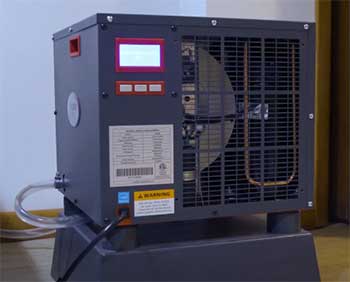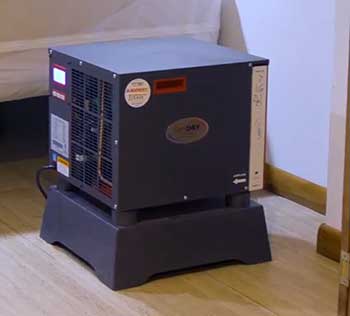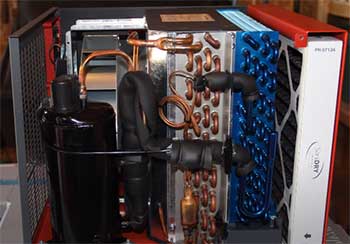The SaniDry Sedona dehumidifier promises to keep your home dry and comfortable while blending into your existing decor. With its sleek, modern design and whisper-quiet operation, it seems too good to be true. Sadly, for many owners, the SaniDry Sedona fails to live up to expectations.
In this guide, we’ll take an in-depth look at the most common SaniDry Sedona problems and provide troubleshooting tips to get your unit working properly again. We’ll also discuss whether it’s worth repairing this dehumidifier or if you’re better off replacing it.
Problems With SaniDry Sedona Dehumidifier
Here is a list of those issues:
Not Actually That Quiet
- Plugs Up Easily, Causes Leaks
- Questionable Moisture Removal
- Fragile Construction
- Inaccurate Humidity Readings
- Drain Hose Detaches Too Easily
- Front Panel Falls Off Easily
Let’s talk about these problems in detail.
Problem #1: Not Actually That Quiet

One of the major selling points of the Sedona is its whisper-quiet operation.
The manufacturer claims this dehumidifier runs at around 50 decibels, which is just above a refrigerator’s hum.
Unfortunately, most users find the Sedona is significantly louder.
Many compare the operating volume to a window air conditioner, hovering around 60 decibels or louder.
That may not seem like much, but sustaining that level of noise 24/7 quickly becomes grating.
What causes the excessive noise? In most cases, owners trace it back to vibration. Internal components and body panels resonate while the compressor cycles on and off. This transmits vibrations directly into the air instead of damping them. The result is a loud “buzzing” or “rattling” that disrupts the intended serene operation.
Troubleshooting tips:
- Make sure the unit sits on a level, stable surface – any rocking can worsen vibrations
- Try placing rubber feet or pads under the dehumidifier to absorb resonance
- Check for loose screws/fittings that may contribute to rattling
- Return unit for repair/replacement if noise persists at disruptive levels
Sadly, many Sedona owners find the noise issue persists even after troubleshooting. Without adequate internal damping, the unit seems prone to transmitting bothersome vibrations.
Problem #2: Plugs Up Easily, Causes Leaks
Another common complaint is that the Sedona’s internal condensate pump fails prematurely, leading to leaks and other issues.
The pump is designed to automatically remove collected moisture so the unit can run continuously. Tubing routes water from the reservoir to a drainage port on the rear of the dehumidifier.
However, numerous owners report their Sedona pump started plugging up after a few months of use. Sediment builds up in the pump impeller and tubing, eventually seizing the mechanism entirely.
Once pumping action stops, the internal reservoir overflows and leaks out the bottom of the unit. At best, this causes puddling around the dehumidifier. But if unnoticed, overflowing water can seep under walls and lead to extensive water damage.
The pump failures seem tied to quality control issues. Internal debris enters the system during manufacturing, eventually gumming up the impeller. Replacement parts have the same problem. So the issues recur even after repairing or replacing the original pump.
Troubleshooting tips:
- Watch for signs of leaking like water under the unit
- Listen for pump noises – failure is often preceded by straining sounds
- Try flushing debris from pump by back-flushing with water
- Replace pump module with updated part if flushing fails
- Install external condensate pump as alternative drainage solution
While it is possible to replace the plug-prone internal pump, most owners end up installing a separate external condensate pump. This more robust accessory sits outside the humidifier to provide reliable water removal. Just take care to prevent leaks from the original internal system.
Problem #3: Questionable Moisture Removal

The whole point of a dehumidifier is removing excess moisture from the air.
Unfortunately, many Sedona owners feel this unit underperforms and fails to keep humidity at desired levels.
Owners with damp basements or whole-home ventilation needs are especially disappointed.
The 50-pint rating suggests decent moisture removal for spaces up to 3000 square feet.
But users consistently find the actual water extraction seems much lower, even in smaller rooms.
Limited air movement is a likely cause. The Sedona lacks anything besides a basic fan to draw air through the system. With no accelerator fan or secondary circulation fans, air doesn’t pass over the coils efficiently. Low airflow means less moisture gets condensed out of each batch of air.
Inadequate defrost mechanisms may also limit moisture removal. Units tend to frost up frequently in cool, damp conditions. But the Sedona lacks a true defrost function to clear ice buildup. It relies solely on pausing the compressor to let ice melt off coils – a slow process that keeps efficiency low.
Troubleshooting tips:
- Make sure nothing blocks airflow into the unit
- Use dehumidifier in enclosed space for best moisture removal
- Set fan to high and reduce humidistat setting to “force” more moisture removal
- Improve airflow by placing unit near a circulating fan
- Consider a more powerful compressor model if issues persist
Improving airflow and reducing the target humidity level can help. But in many cases, the Sedona simply cannot extract enough moisture to control humidity. A different dehumidifier with greater airflow and water removal capacities is needed.
Problem #4: Fragile Construction
The final limitation is the overall flimsy build quality of the Sedona. For the price, owners expect a reasonably durable dehumidifier that will last for years. Sadly, that’s not the reality.
A host of construction issues crop up as flaws in the design and manufacturing:
- Plastic housing and fittings easily crack – Owners report cracks that allow water leaks or air blowing out the sides instead of the vent. Replacing components is difficult.
- Doors and knobs break – The plastic access doors and control knobs snap or fall off easily during use or while cleaning.
- Wheels detach – Wheels give out under moderate loads and fall off. Without wheels, the unit becomes a pain to move.
- Coils prone to damage – Thin, aluminum evaporator coils dent and bend easily, affecting performance.
- Compressor failures – Weak sealing and improper mounting leads to premature compressor burnout.
General lack of quality control means every Sedona unit has the probability of these defects emerging. While some degradation is expected over years, components should not fail after months of gentle use.
Troubleshooting tips:
- Handle plastic components gently to avoid cracking
- Check fittings for leaks and secure if possible
- Superglue or epoxy can temporarily fix broken knobs
- Replace damaged wheels with higher-load alternatives
- Straighten coils if dented; replace if coils leak
- Return unit if compressor failure occurs under warranty
But given the extensive flaws and weaknesses, repairing individual components often proves fruitless. Those considering a Sedona should research whether warranty coverage applies to their issues. In many cases, however, replacing the unit becomes the only viable option.
Problem #5: Inaccurate Humidity Readings

The digital humidistat is one of the main controls on the Sedona, allowing you to set your desired humidity level.
Unfortunately, many owners report the readings are inaccurate and fluctuate wildly.
The sensor often gets “stuck” at a certain percentage, like showing 60% humidity when a separate meter reads 40%.
Without accurate data, you cannot rely on the unit to maintain the indoor humidity level.
The control board seems prone to loose solder joint connections which intermittently disrupt communication with the sensor. The fluctuations and sticking lead to humidifier turning on/off incorrectly.
Troubleshooting tips:
- Make sure nothing blocks the sensor on the front of the unit
- Gently thump or move the control panel to “unstick” the sensor
- Replace control board if issue persists after debris/obstructions removed
While a replacement board may resolve the sticking for a time, the underlying solder joint issue remains. Most owners find they cannot ever trust the readings. Using a separate humidity gauge is recommended.
Problem #6: Drain Hose Detaches Too Easily
The included drainage hose has a quick-release connection where it attaches to the rear drain port. This allows you to pull the hose off for storage. But owners report the release connector is far too loose.
Normal vibrations and small tugs cause the drainage hose to detach completely while running. Without the hose in place, condensate overflows the drain pan and leaks from the rear of the unit.
Like other quick-connect fittings, the release connector likely has loose tolerances from the factory. Simple vibrations can overcome the weak friction fit.
Troubleshooting tips:
- Hand tighten the release connector multiple turns to provide a tighter fit
- Use zip ties or clamps to firmly secure the connection and hose
- Apply Teflon plumber’s tape to create a tighter friction fit
Most owners have to go beyond just tightening the connection – they secure the hose with cable ties or clamps. But you must remember to cut those ties to detach the hose later on.
Problem #7: front Panel Falls Off Easily
The Sedona’s front plastic panel aims for quick and easy filter access. But the designers seem to have gone overboard making the panel detachable. It falls off with the slightest bump or movement of the unit.
Tab connectors on the panel simply pop out of brackets on the main housing. The minimal support leads front covers detaching and dangling by a couple wires. This leaves the internal components exposed.
Beyond appearance issues, easily displaced covers contribute to the Sedona’s overall flimsy build quality. Components and connections inside become disturbed by falling panels.
Troubleshooting tips:
- Push panel firmly to ensure tab connectors are fully seated in brackets
- Consider applying small dots of super glue to the tabs to secure panel
- Use Velcro or magnets to firmly attach panel while still keeping it removable
- Replace with aftermarket front cover that screws into place for durability
Securing the problematic front cover is vital – whether with glue, new fasteners, or replacement parts. Owners shouldn’t have to tolerate such shoddy construction when using their Sedona.
Is Repairing Worth the Cost and Effort?
Before sinking more money into a problematic Sedona, consider whether repairs make financial sense.
Replacement parts often run $50 to over $200. Add the cost of your time for troubleshooting. Then factor in the likelihood that additional issues will occur down the road.
For many owners, putting more money into an underperforming unit with inherent design flaws makes little sense. They are better off replacing their Sedona with a more reliable dehumidifier.
However, if your Sedona is still under warranty, contact the manufacturer about coverage for repair costs. Just don’t get your hopes up too high – the warranty is fairly limited on this unit.
Time for An Upgrade? Alternative Dehumidifier Options
If you decide replacing your Sedona is the right move, put the funds toward a better quality dehumidifier. Look for options with:
- Sturdy metal construction
- Noise-damping features
- Larger water removal capacities
- Robust condensate pumps
- Improved defrost mechanisms
- Additional circulation or accelerator fans
- Readily available replacement parts
Sticking with a major brand known for dehumidification may serve you better than the budget-priced Sedona.
Some well-regarded alternatives to consider include:
- Frigidaire FFAD7033R1 – 70 Pint Capacity with Effortless Humidity Control
- hOmeLabs 4,500 Sq. Ft Energy Star Dehumidifier
- Ivation 70 Pint Energy Star Dehumidifier with Built-In Pump
- AlorAir Sentinel HDi90 Energy Star Dehumidifier
While pricier upfront, a high-performing dehumidifier will save you headaches and provide superior moisture removal for your home. Avoid false economies and ensure your replacement unit improves on the Sedona’s shortcomings.
Frequently Asked Questions About the SaniDry Sedona
Still have some lingering questions about the troublesome SaniDry Sedona? Here are answers to some of the most common queries:
The manufacturer provides a 1-year limited warranty on parts and a 3-5 year warranty (depending on model) on the compressor. But many defects fall outside coverage – read terms closely.
Around 580 watts on average. Costs about $0.06 per kWh, so roughly $3.50 to $4 in electricity per day. Provides poor efficiency for the energy use.
Manufacturer recommends rinsing the filter every two weeks to keep it clean. Replace with a new filter ($15-20) every 6-12 months for best performance.
SaniDry is owned by Devasa, a manufacturer known for low-priced appliances and questionable quality control. Products are made in China.
The Last Word on the Sedona
The SaniDry Sedona clearly falls short as a residential dehumidifier. Major flaws in noise, water removal, durability, and reliability leave most owners dissatisfied. While suitable for occasional, light-duty use, we cannot recommend the Sedona for serious humidity control.
We hope this guide has provided helpful insights if you’re experiencing issues with your Sedona, or debating a purchase. Ultimately, you can likely find superior performance and value from alternative dehumidifiers.
When humidity is a health concern, you need equipment that eliminates moisture efficiently and reliably. Sadly, the attractive yet underachieving Sedona fails that test for most users.
